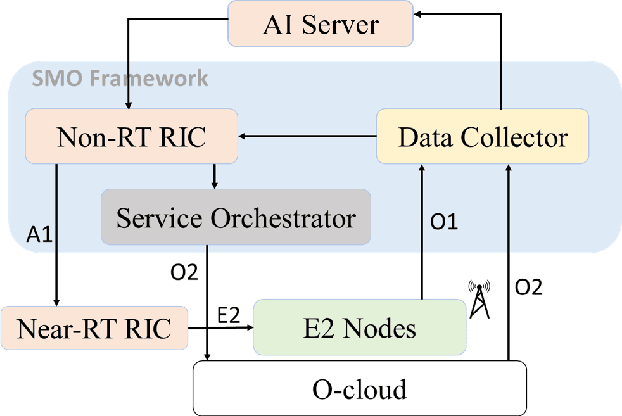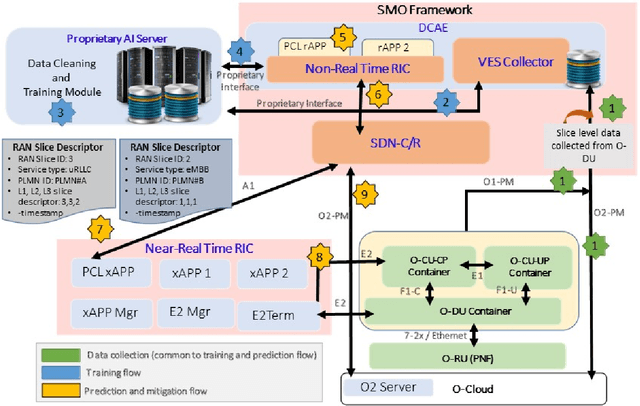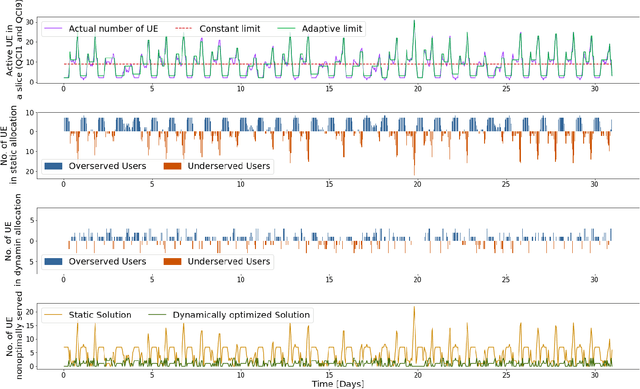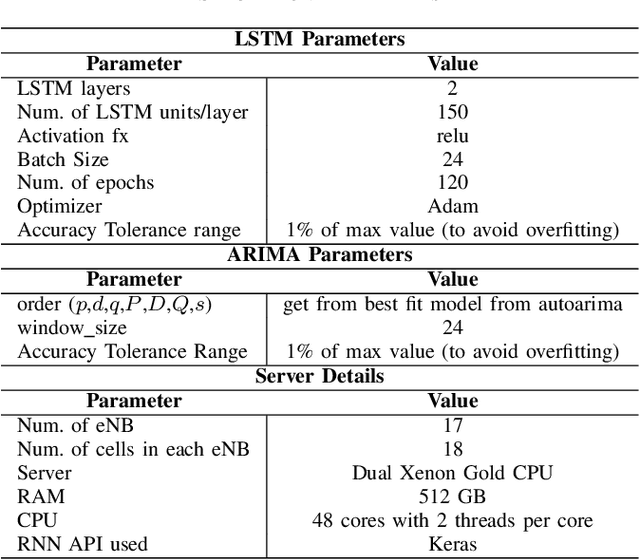Solmaz Niknam
Predictive Closed-Loop Service Automation in O-RAN based Network Slicing
Feb 04, 2022



Abstract:Network slicing provides introduces customized and agile network deployment for managing different service types for various verticals under the same infrastructure. To cater to the dynamic service requirements of these verticals and meet the required quality-of-service (QoS) mentioned in the service-level agreement (SLA), network slices need to be isolated through dedicated elements and resources. Additionally, allocated resources to these slices need to be continuously monitored and intelligently managed. This enables immediate detection and correction of any SLA violation to support automated service assurance in a closed-loop fashion. By reducing human intervention, intelligent and closed-loop resource management reduces the cost of offering flexible services. Resource management in a network shared among verticals (potentially administered by different providers), would be further facilitated through open and standardized interfaces. Open radio access network (O-RAN) is perhaps the most promising RAN architecture that inherits all the aforementioned features, namely intelligence, open and standard interfaces, and closed control loop. Inspired by this, in this article we provide a closed-loop and intelligent resource provisioning scheme for O-RAN slicing to prevent SLA violations. In order to maintain realism, a real-world dataset of a large operator is used to train a learning solution for optimizing resource utilization in the proposed closed-loop service automation process. Moreover, the deployment architecture and the corresponding flow that are cognizant of the O-RAN requirements are also discussed.
Intelligent O-RAN for Beyond 5G and 6G Wireless Networks
May 17, 2020



Abstract:Building on the principles of openness and intelligence, there has been a concerted global effort from the operators towards enhancing the radio access network (RAN) architecture. The objective is to build an operator-defined RAN architecture (and associated interfaces) on open hardware that provides intelligent radio control for beyond fifth generation (5G) as well as future sixth generation (6G) wireless networks. Specifically, the open-radio access network (O-RAN) alliance has been formed by merging xRAN forum and C-RAN alliance to formally define the requirements that would help achieve this objective. Owing to the importance of O-RAN in the current wireless landscape, this article provides an introduction to the concepts, principles, and requirements of the Open RAN as specified by the O-RAN alliance. In order to illustrate the role of intelligence in O-RAN, we propose an intelligent radio resource management scheme to handle traffic congestion and demonstrate its efficacy on a real-world dataset obtained from a large operator. A high-level architecture of this deployment scenario that is compliant with the O-RAN requirements is also discussed. The article concludes with key technical challenges and open problems for future research and development.
Reinforcement Learning for Mitigating Intermittent Interference in Terahertz Communication Networks
Mar 10, 2020



Abstract:Emerging wireless services with extremely high data rate requirements, such as real-time extended reality applications, mandate novel solutions to further increase the capacity of future wireless networks. In this regard, leveraging large available bandwidth at terahertz frequency bands is seen as a key enabler. To overcome the large propagation loss at these very high frequencies, it is inevitable to manage transmissions over highly directional links. However, uncoordinated directional transmissions by a large number of users can cause substantial interference in terahertz networks. While such interference will be received over short random time intervals, the received power can be large. In this work, a new framework based on reinforcement learning is proposed that uses an adaptive multi-thresholding strategy to efficiently detect and mitigate the intermittent interference from directional links in the time domain. To find the optimal thresholds, the problem is formulated as a multidimensional multi-armed bandit system. Then, an algorithm is proposed that allows the receiver to learn the optimal thresholds with very low complexity. Another key advantage of the proposed approach is that it does not rely on any prior knowledge about the interference statistics, and hence, it is suitable for interference mitigation in dynamic scenarios. Simulation results confirm the superior bit-error-rate performance of the proposed method compared with two traditional time-domain interference mitigation approaches.
Federated Learning for Wireless Communications: Motivation, Opportunities and Challenges
Sep 06, 2019



Abstract:There is a growing interest in the wireless communications community to complement the traditional model-based design approaches with data-driven machine learning (ML)-based solutions. While conventional ML approaches rely on the assumption of having the data and processing heads in a central entity, this is not always feasible in wireless communications applications because of the inaccessibility of private data and large communication overhead required to transmit raw data to central ML processors. As a result, decentralized ML approaches that keep the data where it is generated are much more appealing. Owing to its privacy-preserving nature, federated learning is particularly relevant for many wireless applications, especially in the context of fifth generation (5G) networks. In this article, we provide an accessible introduction to the general idea of federated learning, discuss several possible applications in 5G networks, and describe key technical challenges and open problems for future research on federated learning in the context of wireless communications.
 Add to Chrome
Add to Chrome Add to Firefox
Add to Firefox Add to Edge
Add to Edge